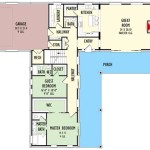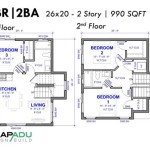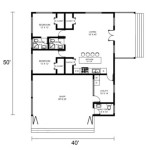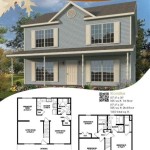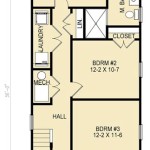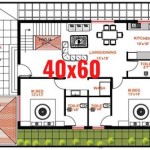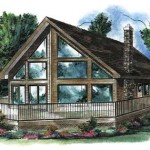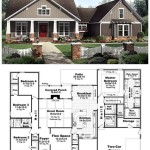Small Craftsman Style House Plans: A Detailed Exploration
The Craftsman architectural style, originating in the early 20th century, embodies simplicity, functionality, and a connection to nature. Small Craftsman style house plans represent a popular adaptation of this aesthetic, offering homeowners the charm and character of the style in a more compact and often more affordable form. These plans are particularly appealing for individuals and families seeking efficient living spaces without sacrificing architectural detail and quality craftsmanship. This article will delve into the defining characteristics, key features, and considerations involved in choosing and implementing small Craftsman style house plans.
Defining Characteristics of Craftsman Architecture
Craftsman architecture distinguishes itself through a number of readily identifiable features, each contributing to its overall aesthetic appeal and practical design. Understanding these characteristics is crucial when evaluating small Craftsman style house plans to ensure authenticity and adherence to the core principles of the style.
One of the most prominent characteristics is the use of natural materials. Wood, stone, and brick are commonly employed in both the exterior and interior of Craftsman homes. Exposed rafters, wide eaves, and substantial porch supports, often made of wood, are hallmarks of the exterior. Inside, wood trim, built-in cabinetry, and hardwood floors contribute to the warm and inviting atmosphere.
Another defining feature is the emphasis on handcrafted details. This includes intricate trim work, custom cabinetry, and unique hardware. The Craftsman movement arose in part as a reaction against the mass-produced goods of the Industrial Revolution, and the emphasis on handcrafted elements reflects a commitment to quality and artistry. Stained glass windows, though not universally present, are another common element that adds to the handcrafted feel.
A low-pitched roof with wide, overhanging eaves is also characteristic. This roof design not only provides shelter and protection from the elements but also contributes to the visual appeal of the house. The eaves often feature exposed rafter tails, further emphasizing the use of natural materials and handcrafted details. Dormers, if present, are typically gabled and aligned with the windows below.
Finally, the presence of a front porch is a defining aspect. The porch serves as a transition space between the interior and exterior, inviting residents to relax and connect with the surrounding environment. Porches are often supported by substantial columns or piers, frequently made of wood or stone. The porch is designed to be a livable extension of the home, encouraging social interaction and outdoor enjoyment.
Key Features of Small Craftsman Style House Plans
Small Craftsman style house plans incorporate the defining characteristics of the Craftsman style while adapting them to a smaller footprint. This requires careful planning and efficient use of space to maximize functionality and maintain the aesthetic integrity of the design.
Open floor plans are common in small Craftsman designs. This allows for a greater sense of spaciousness and facilitates natural light flow throughout the house. The living room, dining area, and kitchen are often integrated into a single, open space, creating a central hub for family activities and gatherings. This arrangement also optimizes the use of available square footage, making the house feel larger than it actually is.
Built-in storage solutions are another key feature. Craftsman architecture has always emphasized practicality and functionality, and built-in cabinets, shelves, and benches are common in small Craftsman houses. These built-in elements help to maximize storage space and minimize clutter, contributing to a more organized and efficient living environment. They also add to the architectural charm of the house, showcasing the craftsmanship and attention to detail that are hallmarks of the style.
The utilization of natural light is paramount. Large windows are strategically placed to maximize natural light penetration, reducing the need for artificial lighting during the day. Clerestory windows, skylights, and strategically positioned mirrors can further enhance the natural light flow. The use of light-colored walls and ceilings also helps to reflect light and brighten the interior spaces.
The inclusion of outdoor living spaces, such as porches, patios, and decks, is vital. Even in a small house, the connection to the outdoors remains important. A well-designed porch or patio can serve as an extension of the living space, providing a place to relax, entertain, and enjoy the surrounding landscape. These outdoor spaces are often integrated seamlessly with the interior of the house, creating a cohesive and harmonious living environment.
Efficient kitchen designs are essential. In a small Craftsman house, the kitchen must be both functional and aesthetically pleasing. Compact layouts, such as galley kitchens or L-shaped kitchens, are often used to maximize space. Smart storage solutions, such as pull-out shelves and vertical storage, help to keep the kitchen organized and clutter-free. The use of natural materials, such as wood cabinets and granite countertops, adds to the Craftsman aesthetic.
Considerations When Choosing Small Craftsman House Plans
Selecting the right small Craftsman style house plan requires careful consideration of individual needs, preferences, and the specific characteristics of the building site. Several factors should be taken into account to ensure that the chosen plan is a good fit.
Lifestyle considerations are paramount. The house plan should align with the occupants' lifestyle and daily routines. Factors such as the number of bedrooms and bathrooms, the need for a home office or entertainment space, and the importance of outdoor living should be carefully considered. The layout of the house should facilitate the flow of daily activities and provide comfortable and functional living spaces.
Budgetary constraints must be realistically assessed. Building a house, even a small one, can be a significant financial investment. It is essential to establish a realistic budget and to choose a house plan that aligns with it. Factors such as the cost of materials, labor, permits, and site preparation should be taken into account. Choosing a simpler design with fewer intricate details can help to reduce construction costs.
Site considerations play a crucial role. The house plan should be appropriate for the specific characteristics of the building site. Factors such as the topography, soil conditions, climate, and local building codes should be taken into account. The orientation of the house on the site should be optimized to maximize natural light and minimize energy consumption. The size and shape of the lot will also influence the choice of house plan.
Energy efficiency is an increasingly important consideration. Choosing a house plan that incorporates energy-efficient features can help to reduce utility bills and minimize environmental impact. This includes features such as energy-efficient windows, insulation, and HVAC systems. Passive solar design principles, such as orienting the house to maximize solar gain in the winter and minimize it in the summer, can also contribute to energy efficiency.
Future needs should be anticipated. While the initial focus may be on current needs, it is important to consider how those needs may change over time. Factors such as the potential for a growing family, the desire to age in place, and the need for additional storage space should be taken into account. Choosing a house plan that can be easily adapted or expanded in the future can provide greater flexibility and long-term value.
The availability of local builders with experience in Craftsman style construction is a critical factor. Craftsman architecture often involves intricate details and specialized techniques, so it is important to choose a builder who is familiar with the style and has a proven track record of quality craftsmanship. A skilled builder can ensure that the house is constructed to the highest standards and that the architectural details are accurately executed.
Finally, it is important to consider the resale value of the house. While the primary focus should be on creating a home that meets the current needs and preferences of the occupants, it is also wise to consider the potential resale value. Choosing a well-designed and well-built Craftsman style house can be a good investment, as these houses are often highly sought after by homebuyers.

House Plan 009 00121 Bungalow 966 Square Feet 2 Bedrooms 1 Bathroom Style Plans Craftsman

Small Craftsman Cottage Plan 94371 At Family Home Plans In Our Best Ing Floor Collection Style House

Plan 001h 0124 The House

Craftsman Bungalow House Plan Porte Cochere 3 Bed Bath

Craftsman Style House Plans Big And Small Houseplans Blog Com

Craftsman House Plans Home Floor Monster

Craftsman Style House Plans Big And Small Houseplans Blog Com

Bungalow House Plans We Love Blog Homeplans Com

Plan 025h 0244 The House

The Dewfield Small Craftsman House Plan Plans Style

